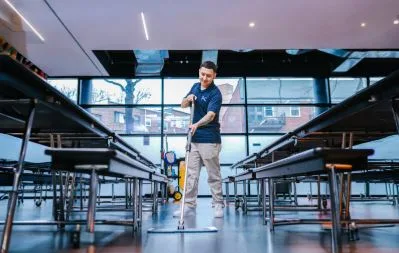NYC’s Polished Prowess: How New York City’s Floors Master the Art of Enduring Elegance
New York City, a vibrant tapestry of commerce, culture, and relentless motion, demands a level of resilience and aesthetic appeal that extends right down to its foundations – its floors. From the bustling lobbies of Midtown skyscrapers to the meticulous pathways of gallery spaces in Chelsea, the condition of a floor speaks volumes about the establishment it serves. In a city where first impressions are paramount and foot traffic is ceaseless, the pursuit of immaculate and enduring surfaces is not merely a preference, but a strategic necessity. This is where specialized approaches to maintaining these critical assets come into play, offering a spectrum of advanced methodologies and technologies designed to tackle the unique challenges presented by the urban environment. For those seeking comprehensive and effective strategies to maintain their properties, exploring premier floor care solutions in New York City is an essential step towards preserving both the beauty and longevity of their investments.
The NYC Floor Gauntlet: Understanding the Unique Challenges
The sheer volume and diversity of activity within New York City’s five boroughs present an unparalleled set of challenges for floor maintenance. Every type of flooring, from polished concrete in SoHo lofts to marble in historic financial institutions, faces a relentless assault from various sources.
- High Foot Traffic: Millions of residents and tourists traverse the city daily, dragging in dirt, grit, and moisture, which act as abrasive agents on floor surfaces.
- Environmental Factors: The city’s fluctuating weather, from humid summers to snowy winters, brings a constant influx of water, salt, and grime indoors, necessitating robust protective measures.
- Diverse Building Usage: Commercial spaces, residential complexes, retail outlets, healthcare facilities, and industrial sites each have distinct demands, requiring customized floor care approaches.
- Aging Infrastructure: Many iconic New York City buildings boast historic flooring materials that require specialized, delicate care to prevent damage and preserve their original grandeur.
- Pest Control Integration: In an urban environment, integrated pest management often considers the cleanliness of floors as a preventative measure against common city pests.
Beyond the Mop and Bucket: The Evolution of Floor Care
Gone are the days when rudimentary cleaning methods sufficed. Modern floor care has transformed into a sophisticated science, leveraging cutting-edge equipment, eco-friendly formulations, and data-driven strategies to achieve superior results. This evolution is particularly crucial in a city as demanding as New York, where efficiency and effectiveness are paramount.
Tailored Treatments for Every Surface
One size does not fit all when it comes to floor care. The specific material dictates the appropriate cleaning agents, equipment, and maintenance schedule.
- Hardwood Floors: Require gentle cleaning, regular polishing, and protective coatings to maintain their luster and prevent scratches. Humidity control is also vital to prevent warping.
- Marble and Natural Stone: Demand pH-neutral cleaners and specialized sealing to prevent etching and staining. Regular honing and polishing are necessary to restore their natural sheen.
- Concrete Floors: Can be polished, sealed, or coated to enhance durability, aesthetics, and resistance to chemicals and abrasion.
- Vinyl Composition Tile (VCT) and Linoleum: Benefit from regular stripping, waxing, and buffing to maintain their appearance and protective layers.
- Carpet: Requires frequent vacuuming, spot cleaning, and periodic deep extraction to remove embedded dirt, allergens, and odors.
The Science of Restoration: Bringing Floors Back to Life
Even well-maintained floors can eventually show signs of wear and tear. Floor restoration services are designed to address significant damage, returning surfaces to their original glory or even enhancing them. This often involves:
- Deep Cleaning and Stripping: Removing accumulated layers of dirt, old finishes, and grime to expose the original surface.
- Repair and Patching: Addressing cracks, chips, and gouges to ensure a smooth and safe surface.
- Grinding and Honing: For natural stone and concrete, this process levels the surface and prepares it for polishing, removing imperfections.
- Polishing: Using specialized abrasives to achieve varying levels of sheen, from a matte finish to a high-gloss mirror-like shine.
- Sealing and Coating: Applying protective layers that guard against future damage, enhance durability, and simplify ongoing maintenance.
The Economic Imperative: Why Professional Floor Care Pays Off
Investing in professional floor care might seem like an added expense, but it delivers significant long-term economic benefits, especially in a high-value real estate market like New York City.
- Extended Floor Lifespan: Proper maintenance significantly prolongs the life of flooring materials, delaying costly replacements.
- Enhanced Property Value: Pristine floors contribute to a positive perception of the property, increasing its marketability and value.
- Improved Safety: Clean, well-maintained floors reduce slip-and-fall hazards, mitigating potential liabilities.
- Better Indoor Air Quality: Regular deep cleaning of carpets and hard surfaces reduces dust, allergens, and pollutants, contributing to a healthier indoor environment.
- Positive Brand Image: For businesses, immaculate floors reflect professionalism and attention to detail, enhancing customer perception and brand reputation.
Sustainability in the Spotlight: Eco-Conscious Floor Care
In an increasingly environmentally aware city, sustainable floor care practices are gaining prominence. Reputable providers are adopting greener approaches that minimize environmental impact without compromising effectiveness.
- Eco-Friendly Cleaning Solutions: Utilizing biodegradable, non-toxic, and low-VOC (volatile organic compound) cleaning products.
- Water Conservation: Employing equipment and techniques that minimize water usage, such as low-moisture carpet cleaning or reclamation systems for hard surface washing.
- Waste Reduction: Implementing strategies to reduce waste from cleaning supplies and packaging.
- Energy-Efficient Equipment: Utilizing modern machinery that consumes less energy.
- Recycling Programs: Partnering with facilities that can recycle discarded flooring materials when replacement becomes unavoidable.
The Future of Floors: Innovations on the Horizon
The field of floor care is continually evolving, with new technologies and methodologies emerging to address complex challenges. Looking ahead, we can anticipate further advancements that will make floor maintenance even more efficient, effective, and sustainable.
- Robotics and Automation: Increased deployment of autonomous cleaning robots for routine maintenance, freeing up human staff for more specialized tasks.
- IoT-Enabled Systems: Smart sensors and data analytics providing real-time insights into floor condition, enabling predictive maintenance and optimized cleaning schedules.
- Advanced Protective Coatings: Development of even more durable, self-healing, and antimicrobial coatings that offer enhanced protection and hygiene.
- Bio-Enzymatic Cleaners: Wider adoption of biological cleaning agents that break down organic matter, offering deep cleaning without harsh chemicals.
Conclusion
In the dynamic urban landscape of New York City, where every square foot is a valuable asset, the importance of robust and comprehensive floor care cannot be overstated. From preserving historical integrity to ensuring modern functionality, the right approach to floor maintenance is a cornerstone of property management. It’s an investment that yields dividends in longevity, aesthetics, safety, and economic value. As the city continues to evolve, so too will the methods and technologies employed to keep its foundations gleaming, ensuring that the ground beneath our feet remains as resilient and impressive as the city itself. For deeper insights into maintaining various surfaces and ensuring their longevity, consider exploring resources on facility maintenance best practices.
FAQ’s
Q1: How often should commercial floors in NYC be professionally cleaned?
A1: The frequency depends heavily on the type of flooring, the amount of foot traffic, and the specific use of the space. High-traffic areas like retail stores or office lobbies might require daily or weekly attention, while other areas could be on a monthly or quarterly schedule. Consult with a floor care specialist for a tailored assessment.
Q2: What are the benefits of floor sealing and waxing?
A2: Sealing and waxing provide a protective layer over your flooring, especially for materials like VCT, linoleum, or concrete. This layer helps prevent scratches, stains, and wear, making the floor easier to clean and extending its lifespan. It also enhances the floor’s appearance with a polished shine.
Q3: Is professional floor care environmentally friendly?
A3: Many professional floor care providers in NYC are increasingly adopting eco-friendly practices. This includes using green cleaning products, water-efficient equipment, and sustainable waste disposal methods. It’s advisable to inquire about their specific green initiatives.
Q4: Can old, damaged floors be restored, or do they always need to be replaced?
A4: In many cases, old and even seemingly damaged floors can be effectively restored, particularly hard surfaces like concrete, marble, or hardwood. Restoration techniques such as grinding, honing, polishing, and refinishing can bring these surfaces back to life, often at a fraction of the cost of replacement.
Q5: How does professional floor care contribute to indoor air quality?
A5: Professional floor care, especially for carpets, significantly improves indoor air quality by removing embedded dust, allergens, pet dander, and other pollutants that can accumulate over time. For hard surfaces, regular cleaning prevents the buildup of dirt and grime that can contribute to airborne particles.




